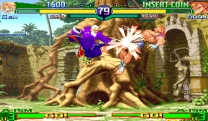


The CPS Changer was sold as a package deal of the console itself, one CPS Fighter joystick controller, and the Street Fighter II ′ (Dash) Turbo game for 39,800 yen. Some CPS1 games were changed slightly for home release, sometimes including debugging features or other easter eggs. This concept was later re-used in the CP System II hardware. The CPS Changer games were simply arcade PCBs in a special plastic shell suitable for home use. The CPS Changer featured Super Famicom controller ports, allowing the use of all Super NES controllers, including their six-button joystick, the "CPS Fighter".Īll of the CPS Changer games used the CPS arcade hardware.

The CPS Changer has outputs for composite video, S-video and line-level mono audio. On a normal JAMMA PCB it would not attach firmly and tended to lean at odd angles, but it would work. Capcom's "protection" against people using the CPS Changer on other arcade boards was the physical shape of the device. The CPS Changer adapter was basically an encased SuperGun (Television JAMMA adapter), and was compatible with most JAMMA standard PCBs. Capcom released the CPS Changer as an attempt to sell their arcade games in a home-friendly format. Unlike the CPS-2, CPS Dash sound ROMs were encrypted using "Kabuki" Z80s.Ī home version of the CPS, the Capcom Power System Changer was released in late 1994 in Japan to compete against the SNK Neo Geo. If the batteries' voltage should drop below +2V, the registers manually defined in factory by Capcom in RAM would be lost, and the PPU would no longer have access to the hardware specific register set on the game used, rendering the game inoperable, and necessitating the operator sending the board to Capcom to be fixed, at his own expense.

#Capcom play system emulator mac code
The CPS-1 Dash 68000 code is not encrypted at all.
#Capcom play system emulator mac manual
To combat piracy, "suicide batteries" were implemented, which power the volatile RAM which contained the manual configuration of the display hardware registers, as well as the priorities registers. The CPS Dash boards have four interlocking PCBs and are contained in gray plastic boxes. Street Fighter II′ (Dash) Turbo: Hyper FightingĪ year before releasing the CPS-2, Capcom released an enhanced version of the original CP System dubbed the Capcom Play System Dash, which had some features that would later be used in the CPS-2, such as the QSound chips. Street Fighter II′ (Dash): Champion Edition Multigame (Beat 'em up, Shoot 'em up & Puzzle game) 68K RAM: 64 KB WORK RAM + 192 KB VRAM(Shadow).Tiles: Sizes 8x8, 16x16, 32x32 with 16 colors (15 unique + 1 transparent).Vertical and Horizontal Flipping capability.Simultaneously displayable: 256 (per scanlines).Onscreen colors: 3072 (192 global palettes with 16 colors each).Color Depth: 16-bit (12-bit RGB with 4-bit brightness value).Primary: Motorola 68000 10 MHz (some later boards 12 MHz).The CPS hardware was also utilized in Capcom's unsuccessful attempt at home console market penetration, the CPS Changer, a domestic version of the CPS similar to SNK's Neo Geo AES. This problem was virtually eliminated by Capcom in the later CPS-2. In particular, there were so many bootleg versions of Street Fighter II, that they were more common in some countries than the official version. The system was plagued by many bootleg versions of its games. After a number of arcade game boards designed to run only one game, Capcom embarked upon a project to produce an arcade system board that could be used to run multiple games, in order to reduce hardware costs and make the system more appealing to arcade operators.


 0 kommentar(er)
0 kommentar(er)
